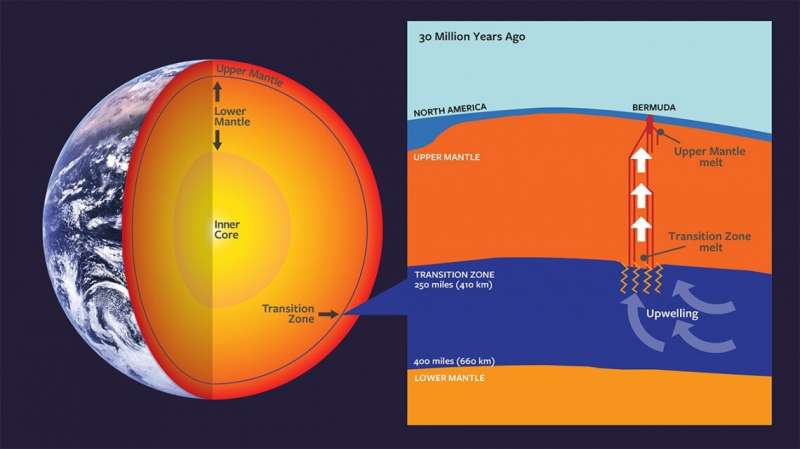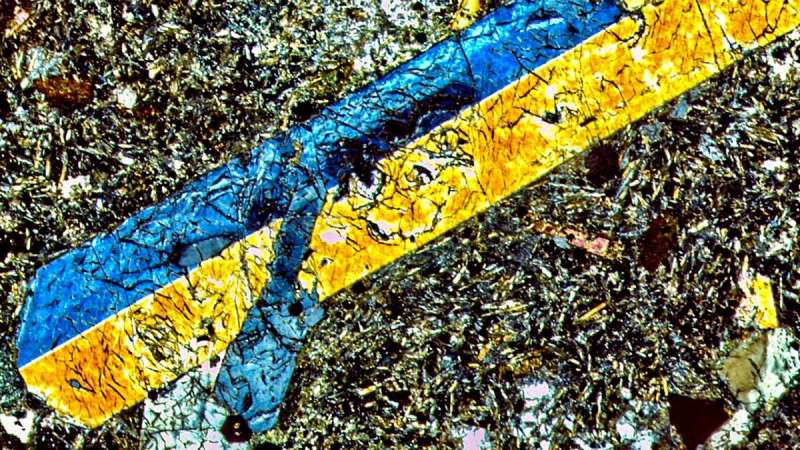From Earth's deep mantle, scientists find a new way volcanoes form

Far below Bermuda's pink sand beaches and turquoise tides, geoscientists have discovered the first direct evidence that material from deep within Earth's mantle transition zone—a layer rich in water, crystals and melted rock—can percolate to the surface to form volcanoes.
Scientists have long known that volcanoes form when tectonic plates (traveling on top of the Earth's mantle) converge, or as the result of mantle plumes that rise from the core-mantle boundary to make hotspots at Earth's crust. But obtaining evidence that material emanating from the mantle's transition zone—between 250 to 400 miles (440-660 km) beneath our planet's crust—can cause volcanoes to form is new to geologists.
"We found a new way to make volcanoes. This is the first time we found a clear indication from the transition zone deep in the Earth's mantle that volcanoes can form this way," said senior author Esteban Gazel, associate professor in the Department of Earth and Atmospheric Sciences at Cornell University. The research published in Nature.
"We were expecting our data to show the volcano was a mantle plume formation—an upwelling from the deeper mantle—just like it is in Hawaii," Gazel said. But 30 million years ago, a disturbance in the transition zone caused an upwelling of magma material to rise to the surface, forming a now-dormant volcano under the Atlantic Ocean and then forming Bermuda.
Using a 2,600-foot (over 700-meter) core sample—drilled in 1972, housed at Dalhousie University, Nova Scotia—co-author Sarah Mazza of the University of Münster, in Germany, assessed the cross-section for isotopes, trace elements, evidence of water content and other volatile material. The assessment provided a geologic, volcanic history of Bermuda.
"I first suspected that Bermuda's volcanic past was special as I sampled the core and noticed the diverse textures and mineralogy preserved in the different lava flows," Mazza said. "We quickly confirmed extreme enrichments in trace element compositions. It was exciting going over our first results ... the mysteries of Bermuda started to unfold."

From the core samples, the group detected geochemical signatures from the transition zone, which included larger amounts of water encased in the crystals than were found in subduction zones. Water in subduction zones recycles back to Earth's surface. There is enough water in the transition zone to form at least three oceans, according to Gazel, but it is the water that helps rock to melt in the transition zone.
The geoscientists developed numerical models with Robert Moucha, associate professor of Earth sciences at Syracuse University, to discover a disturbance in the transition zone that likely forced material from this deep mantle layer to melt and percolate to the surface, Gazel said.
Despite more than 50 years of isotopic measurements in oceanic lavas, the peculiar and extreme isotopes measured in the Bermuda lava core had not been observed before. Yet, these extreme isotopic compositions allowed the scientists to identify the unique source of the lava.
"If we start to look more carefully, I believe we're going to find these geochemical signatures in more places," said co-author Michael Bizimis, associate professor at the University of South Carolina.
Gazel explained that this research provides a new connection between the transition zone layer and volcanoes on the surface of Earth. "With this work we can demonstrate that the Earth's transition zone is an extreme chemical reservoir," said Gazel. "We are now just now beginning to recognize its importance in terms of global geodynamics and even volcanism."
Said Gazel: "Our next step is to examine more locations to determine the difference between geological processes that can result in intraplate volcanoes and determine the role of the mantle's transition zone in the evolution of our planet."
More information: Sarah E. Mazza et al, Sampling the volatile-rich transition zone beneath Bermuda, Nature (2019). DOI: 10.1038/s41586-019-1183-6
Journal information: Nature
Provided by Cornell University





















